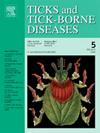Mapping the risk of exposure to Crimean-Congo haemorrhagic fever virus in the Iberian Peninsula using Eurasian wild boar (Sus scrofa) as a model
Abstract
Crimean-Congo haemorrhagic fever (CCHF) virus (CCHFV) is a tick-borne zoonotic pathogen that can cause a lethal haemorrhagic disease in humans. Although the virus appears to be endemically established in the Iberian Peninsula, CCHF is an emerging disease in Spain. Clinical signs of CCHFV infection are mainly manifested in humans, but the virus replicates in several animal species. Understanding the determinants of CCHFV exposure risk from animal models is essential to predicting high-risk exposure hotspots for public health action. With this objective in mind, we designed a cross-sectional study of Eurasian wild boar (Sus scrofa) in Spain and Portugal. The study analysed 5,291 sera collected between 2006 and 2022 from 90 wild boar populations with a specific double-antigen ELISA to estimate CCHFV serum prevalence and identify the main determinants of exposure probability. To do so, we statistically modelled exposure risk with host- and environment-related predictors and spatially projected it at a 10 × 10 km square resolution at the scale of the Iberian Peninsula to map foci of infection risk. Fifty-seven (63.3 %) of the 90 populations had at least one seropositive animal, with seroprevalence ranging from 0.0 to 88.2 %. Anti-CCHFV antibodies were found in 1,026 of 5,291 wild boar (19.4 %; 95 % confidence interval: 18.3–20.5 %), with highest exposure rates in southwestern Iberia. The most relevant predictors of virus exposure risk were wild boar abundance, local rainfall regime, shrub cover, winter air temperature and soil temperature variation. The spatial projection of the best-fit model identified high-risk foci as occurring in most of western and southwestern Iberia and identified recently confirmed risk foci in eastern Spain. The results of the study demonstrate that serological surveys of CCHFV vector hosts are a powerful, robust and highly informative tool for public health authorities to take action to prevent human cases of CCHF in enzootic and emergency settings.

 求助内容:
求助内容: 应助结果提醒方式:
应助结果提醒方式:


